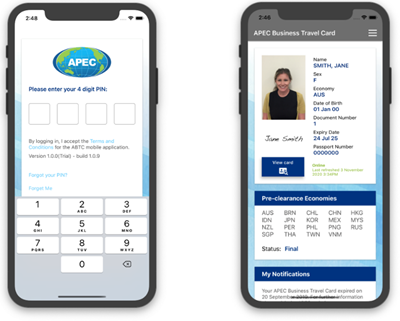Last page update:
The Asia Pacific Economic Cooperation Business Travel Card
- The Asia Pacific Economic Cooperation (APEC) Business Travel Card (ABTC) facilitates short-term business travel within the APEC region by streamlining the entry process into APEC economies. The ‘apply once, information used for multiple purposes’
approach is used which means that applicants are only required to make one application for permission to enter participating economies. Successful applicants from fully participating economies are issued with a five-year card that serves as the
entry authority to other fully participating economies which have granted pre-clearance for short-term business travel of up to 60 or 90 days. The card also enables holders to fast track immigration processing at each economy’s major international
airports. Note that Canada and the United States of America (the United States) are transitional members of the ABTC scheme and do not offer reciprocal entry arrangements, but do provide fast track immigration processing at major international
airports.
- Eligibility Criteria
To be eligible to apply for an ABTC you must hold a valid passport from an APEC economy (or be a permanent resident of the Hong Kong Special Administrative Region (Hong Kong, China), engage in regular business travel throughout the APEC region and have no criminal conviction. Each economy has the discretion to impose additional eligibility criteria on their applicants. Further information about the eligibility criteria of each economy is available through the domestic websites of each economy, accessible via the contact details below.
Senior government officials and officials actively engaged in APEC business may also be eligible for an ABTC. As each economy will define a “senior government official” according to its own bureaucratic structure, please contact your home economy to determine whether you meet this criteria. - Application Process
Applicants make a single application to the economy for which they hold a passport (home economy), or have permanent residence in the case of Hong Kong, China. If this economy assesses the application as meeting the relevant criteria, the applicant’s details are provided to the other participating economies who conduct their own assessment of whether to grant pre-clearance. When all economies have made a pre-clearance decision, the applicant receives an ABTC that lists the economies to which they have permission to travel. Each economy is responsible for managing the processing of their own pre-clearance applications and no economy has any influence over the processing timeframes of another.
ABTC Pre-clearance Status Tracker
Once the home economy has approved the application, applicants can monitor which economies have provided pre-clearance using the ABTC Pre-clearance Status Tracker. If you are applying through Canada or the United States, you may check your application status through your TTP account.
Economy Contact Details and Frequently Asked Questions (FAQ)
A list of Frequently Asked Questions about the ABTC are available here. Any additional questions should be directed to your home economy.
- Questions about applying for the ABTC are managed by your home economy.
- Questions about the status of your pre-clearance application with a particular economy are managed by that economy.
- Questions about the requirements for travelling to a particular economy using your ABTC are managed by the economy to which you intend to travel.
Each economy has information about the ABTC, including relevant contact points available on their domestic websites in the Table below. Please consult this information prior to contacting an economy directly.
Virtual APEC Business Travel Card (ABTC)
 The
APEC Business Mobility Group launched the virtual APEC Business Travel Card (ABTC) during APEC Leader’s Week in
November 2020.
The
APEC Business Mobility Group launched the virtual APEC Business Travel Card (ABTC) during APEC Leader’s Week in
November 2020.
The virtual ABTC is an innovative new method for travelling with the ABTC. It brings the existing scheme into the digital era, providing the much-valued service through cardholders’ smart devices. The virtual ABTC is a more
secure, efficient, convenient and user-friendly service and importantly, it provides real-time updates, so that a cardholder can immediately benefit from using their virtual ABTC.
Travelling on the virtual ABTC allows for the same streamlined and VIP service existing cardholders have come to enjoy, but will provide an alternative method for producing and presenting their card when entering and exiting an APEC economy.

Each Economy will determine its own timeline to transition its cardholders to the virtual ABTC; however, from 1 March 2021 economies can expect to see the first travellers using the virtual ABTC—with Australia being the first APEC economy to transition all their cardholders over to the virtual ABTC. The Business Mobility Group looks forward to seeing other economies transition to the virtual ABTC shortly thereafter.
The virtual ABTC employs security features to provide economies greater confidence to determine that a digital ABTC and cardholder are genuine. These features include:
- Secure sign on – An approved ABTC applicant will be sent an email with a unique token (an individual application number) for their virtual ABTC and a link to download and log onto the virtual ABTC app.
- User authentication – Users are required to ensure their user credentials are authenticated and verified when accessing the virtual ABTC app. Only approved ABTC cardholders who have been granted access to the virtual ABTC can log on—please refer below to the documents below for the step-by-step process.
- Screenshots – On Android devices, users are prevented from taking screenshots of the virtual ABTC; and on iOS devices, users who attempt to take a screenshot of the virtual ABTC will be presented with a message reminding them that airport officials will not accept a screenshot of the virtual ABTC.
- Watermarks – The card screen of the virtual ABTC will have APEC and other discrete security watermark features, making it difficult to fraudulently replicate. The holographic overlay and card background pattern change colour and visibility in real-time in correlation with movement of the smart device, allowing airport officials to quickly confirm that they have been presented with the official virtual ABTC rather than a screenshot or video capture.
These additional security features for the virtual ABTC hinder fraudulent replication and misuse, and protect cardholders and their personal details.
For more information on the virtual ABTC take a look at our videos and information guides below.
Introduction to the Virtual APEC Business Travel Card for Cardholders
Introduction to the Virtual APEC Business Travel Card for Port Officials
Virtual Cardholder Travel Advice
Latest Updates
- Russia
Russia advised that they are unable to accept virtual ABTCs at this time. However, Russia announced a temporary travel scheme for eligible virtual ABTC card holders, commencing on Monday, 10 April 2023.
The temporary travel scheme facilitates a special permit granting a multiple entry and stay visa to Russia. The special permit will be valid for five years from the date of issue and will be issued free of charge in any Russian Federation diplomatic mission or consular office.
To be eligible for the special permit, ABTC holders must:
- have received pre-clearance from Russia and
- not have a physical ABTC.
Russia continues to accept physical ABTCs from all participating APEC economies.
In order to apply for a special permit for multiple trips to Russia, applicants are required to submit a completed visa application form, photo, passport and a personal statement to any diplomatic mission or consular office of Russia abroad.
Taking into account the formal financial regulations in force in diplomatic missions or consular offices of the Russia abroad, the personal statement to the head of a diplomatic mission or consular office of Russia should request to exempt the applicant, on the basis of the principle of reciprocity applied within the APEC forum when processing documents for business and official trips, from charging any fees for issuing the special permit multiple entry visa the same as when using a physical ABTC with a limitation of the total period of stay in Russia of 90 days from each period of 180 days .
An approved permit will be printed on a visa sticker form and pasted into the applicant’s passport.
Virtual ABTC holders may also wish to confirm the status of their pre-clearance to Russia using the ABTC pre-clearance status tracker.

